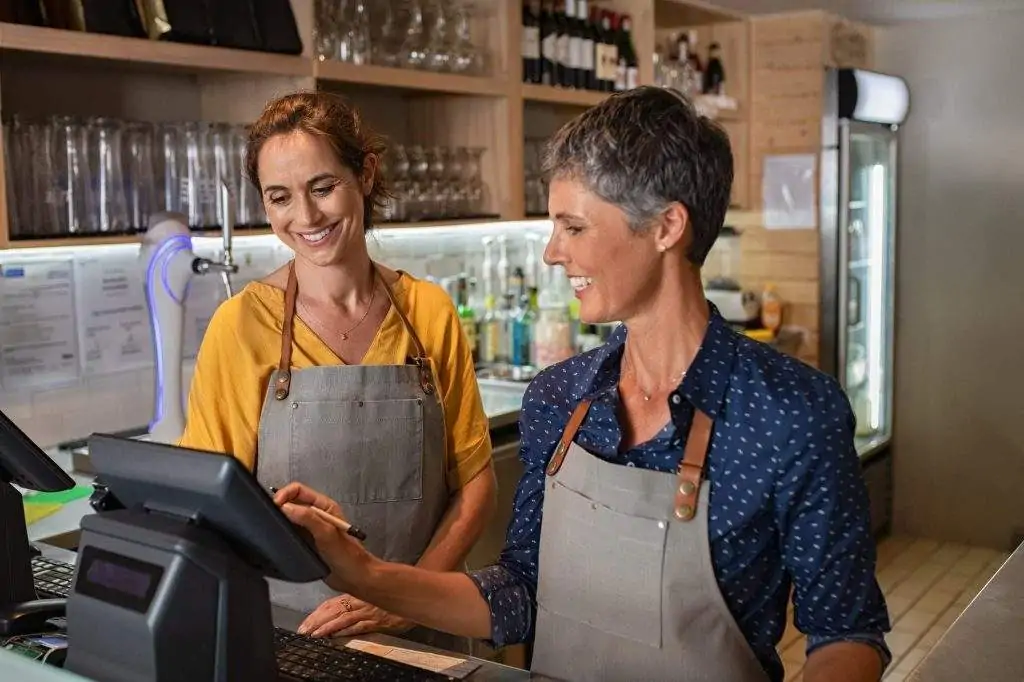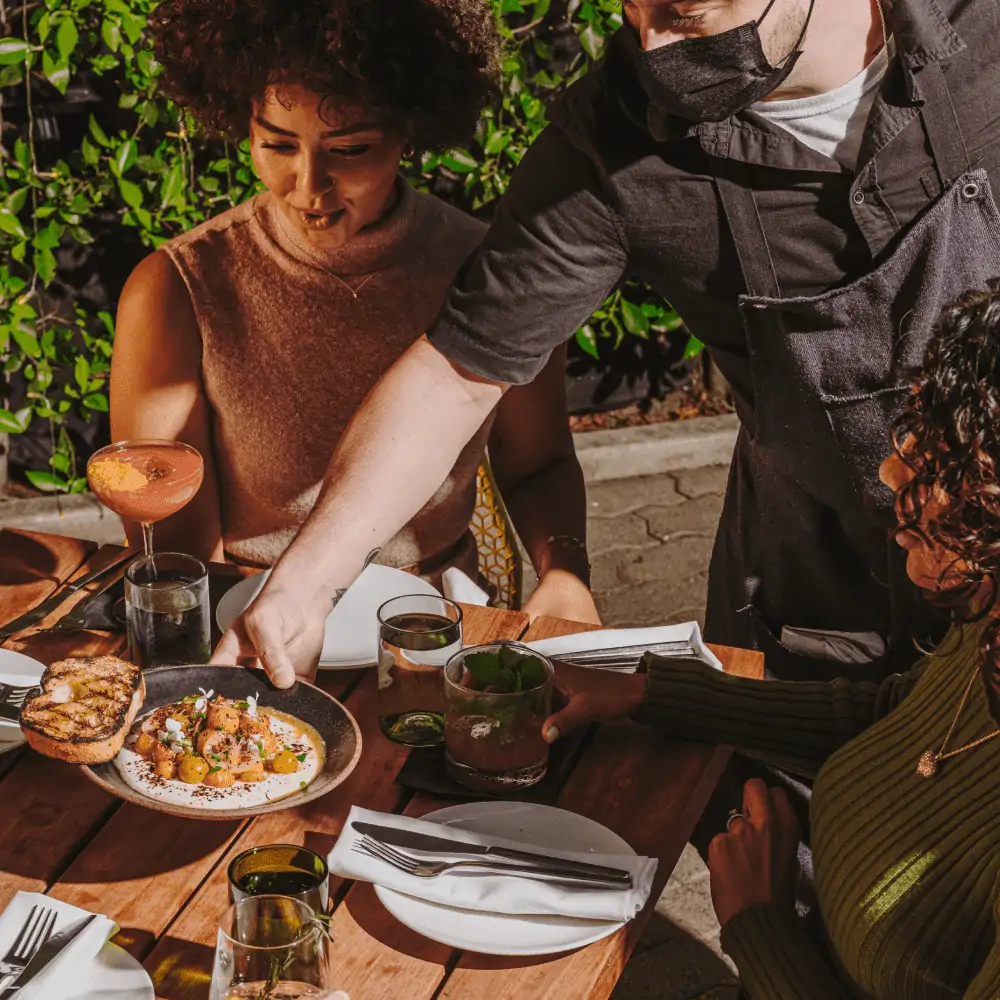Opening a restaurant is a dream for many aspiring entrepreneurs and food lovers alike, but it’s also a complex venture that requires careful planning and execution. With this guide, we walk you through the key steps to turn your restaurant dream into a successful reality. From budgeting and licensing to crafting the perfect menu, here’s everything you need to know about how to open a restaurant.
Quick links
Market research and business plan
Location and layout
Budgeting and costs
Licenses and legal requirements
Creating the menu
Staffing
Technology and systems
Marketing and branding
Opening your restaurant
Market research and business plan
Market research and crafting a solid business plan are foundational steps in opening a restaurant.
Market research
Before you even think about the menu or location, you need to understand the guests who will walk through your doors. Are you targeting families, young professionals, or a little bit of everything? Knowing your audience will inform your menu, but more importantly, your restaurant’s overall vibe and service style.
It’s equally important to study your competition. Visit other restaurants in the area to understand their pricing and see what they’re doing well and what can be improved upon. Doing so will give you a sense of the market gap that needs filling. Are people craving a new Italian place? Is there a shortage of healthy fast-food options? These observations will help carve out your own space in the local food scene.
Business plan
Once you’ve gathered all the necessary information, it’s time to put it into a business plan. This document is helpful for you as well as potential investors.
Start by outlining your restaurant’s concept, from the type of cuisine to the interior design. Include financial projections—how much it will cost to start, what you expect to earn in the first 12 months, and your plans for growth. Don’t forget to detail marketing strategies, which could range from social media advertising to partnerships with local businesses.
Your market research and business plan are the roadmap to your restaurant’s success. They’ll guide every decision you make, from the big ones like location to what goes on your menu.
Location and layout
There’s a real estate mantra, “location location, location”, and this applies to finding the perfect restaurant destination.
Start by thinking about foot traffic, visibility, and accessibility when choosing where to open your restaurant.
Is it easy to find? Can people spot it while strolling down the street? How close is it to public transport, or is there parking nearby? All of these questions need answers because no one wants a restaurant that’s hard to find or impossible to get to.
Once you’ve nailed the perfect location, focus on the layout and interior design. This is where your brand comes to life. The layout should be visually appealing but also functional. Think about the flow of traffic from the kitchen to the tables. Are your staff bumping into each other, or do they have a clear path? Efficiency is key.
Customer experience is another factor, and your interior should resonate with the brand’s personality. Whether it’s chic and modern or rustic and cozy, fine dining or casual, the atmosphere needs to enhance the dining experience and make it memorable for all the right reasons.
Choose wisely and design smartly. Your location and layout are the stage on which your restaurant’s story will unfold.
Budgeting and costs
You have done the research and built a watertight business plan, but what about the actual costs involved with opening a restaurant? These factors are central to making sure you stay within budget.
Choosing the right location will be one of your first financial considerations, whether that means purchasing a property or taking on the costs of rent and a security deposit. Transforming the space to match your restaurant’s theme can also impact the budget, as will acquiring your first round of food, beverages, and other essentials.
But remember, your financial responsibilities extend beyond the grand opening.
You’ll need to cover continuous costs like:
- Utility bills for electricity, water, and gas
- Regularly updating your food and drink inventory
- Paying your staff’s wages
- Budget for promotional activities
- Upkeep of the premises
- Any legal permits or licenses you’ll need to keep the doors open.
Craft a comprehensive financial blueprint to manage your restaurant’s expenses. Whether you’re leaning towards digital accounting solutions or considering the expertise of a financial advisor, staying clued in on your cash flow—both outgoing and incoming—is pivotal for your restaurant’s triumph. Above all, don’t overlook the significance of focusing on your break-even milestone, that crucial juncture where your revenue finally squares up with your expenditures.
Knowing this will give you a clear financial target to aim for and will give you an idea of how long it will take before you start making a profit.
Licenses and legal requirements
Navigating the maze of licenses and legal requirements is another major step in opening a restaurant. There’s plenty to think about, from getting a general business license to copyrighting music.
Business structure
Decide on your business structure early on—whether it’s a sole proprietorship, partnership, or LLC—as this will affect your taxes, liability, and other legal obligations.
Business license
First and foremost, you’ll need a general business license to operate. This is a standard requirement for any business and is usually obtained from your local government.
Health permit
A health permit is mandatory and is issued by the local health department after inspecting your establishment to ensure it meets all health and safety standards.
Liquor license
The process for obtaining a liquor license can be lengthy and expensive, depending on your location and the type of alcohol you plan to serve. Some areas even have a cap on the number of licenses they issue, making it a competitive and sometimes complicated process.
Other permits
You may also need other permits like a:
- Fire department permit
- Signage permit
- Music license if you plan to play copyrighted songs.
Make sure you’re in compliance with all local, state, and federal laws to avoid any legal complications down the line. Being thorough at this stage can save you headaches and financial woes in the future.
Creating the menu
Your menu is the restaurant’s calling card. This isn’t just about what you serve–it’s how you serve it. Think of it as a curated experience for your diners and begin with a deep dive into your ideal guest. Are they health-conscious millennials or families looking for comfort food? Tailor your menu to fit their tastes.
Seasonality is key. Fresh, in-season ingredients taste better and can also reduce costs as they can be sourced locally, which eliminates or reduces the need for long-distance shipping and storage.
Menu engineering is also pivotal. Highlight those high-profit items, maybe even give them a prime spot with an eye-catching description. You want to guide diners to these choices subtly but effectively.
Of course, none of the above matters if your pricing isn’t spot-on. Ever notice how some menus list prices as ’10’ instead of ‘$10.00’? That’s psychological pricing at work and makes the cost seem less daunting. Also, consider bundling items into meal deals or offering a prix fixe menu. It simplifies decision-making for guests and can increase the average order size.
Your menu should be a strategic masterpiece designed to tantalize taste buds while boosting the bottom line. It’s where culinary creativity meets business savvy, and getting it right can set you up for success.
Staffing
Without a great chef, the menu doesn’t stack up. And you can forget about creating a five-star guest experience if the whole team isn’t on board, from the front of house to back of house. Staffing is arguably the most important part of a successful restaurant.
These people are the backbone of your operation. You’re not just hiring people to fill roles. You’re assembling a team that will define the culture and customer experience.
Start with key positions like chefs and kitchen staff, as they’ll be the ones executing your menu to perfection. Don’t underestimate the power of a skilled and charismatic wait staff, either. They’re the face of your restaurant, the ones who interact directly with your customers.
If you’re serving alcohol, experienced bartenders are a must, not just for mixing drinks but for ensuring responsible service and setting the mood when people order a drink before taking their seat.
Training is non-negotiable. Yes, you want to teach the basics, but more than anything, it’s about instilling your restaurant’s values and standards in every team member. Whether it’s a detailed orientation program or ongoing training sessions, make sure your staff knows what to do and how to do it in a way that aligns with your brand and core values.
Customer service skills should be a key focus, as should teamwork and communication. Remember, high staff turnover can be a significant drain on resources. Investing in your team’s development improves service immeasurably while also fostering loyalty and reducing the need for frequent rehiring and retraining. It’s an investment that pays off in the long term.
Technology and systems
The days of technology being a luxury for restaurants are long gone. Now, implementing restaurant technology is a must for any place with grand designs of being successful. Technology streamlines operations and makes everything that much easier, whether it’s using point of sale (POS) systems or a reservations platform.
POS system
A robust Point of Sale (POS) system is your first line of defense against operational chaos. It’s so much more than a way of processing transactions: POS systems track sales, manage inventory, and even generate reports that offer insights into customer behavior. A good POS system can also integrate with other software, creating a seamless operational flow.
Reservations platform
When it comes to reservations, platforms like OpenTable are invaluable. Not only is it easier for diners to book a table, but it also provides you with tools to manage the restaurant’s seating capacity and turnover rates effectively. This is particularly important during peak hours and special occasions when demand is high. With OpenTable, you also get a range of insights and can launch marketing campaigns designed to attract more diners.
Inventory management
Don’t overlook inventory management systems. Knowing what you have, what you need, and when you need it helps run an efficient setup and reduces waste while improving your bottom line. Modern inventory systems can forecast needs based on historical data, automate orders, and even alert you when there’s an issue that needs immediate attention.
Incorporating these technologies will significantly streamline operations, improve customer experience, and give you a competitive edge. It’s an investment that will pay for itself many times over.
Marketing and branding
You can curate the perfect space and put a menu together that makes mouths water, but none of it matters if you don’t get people coming through the door. Marketing and branding play a central role here and are crucial to your restaurant’s long-term success.
Social media
Social media platforms like Instagram and Facebook are great for promotion as they allow you to connect with a range of diners and tell stories through great imagery and videos that capture people’s attention. Use social media to showcase your food, your staff, and your happy guests. These platforms help humanize your brand and create an emotional connection with your audience.
Email campaigns
Email newsletters are another powerful method for building a rapport with diners. They offer value that keeps your audience engaged and are great tools for promotions and announcements. Think recipes, staff profiles, or a behind-the-scenes look at your sourcing practices.
OpenTable
Don’t forget platforms like OpenTable, which offer more than just reservation services. Being on OpenTable also means taking advantage of marketing benefits, like featuring your restaurant in targeted campaigns, offering special promotions, and guest reviews that can shine a light on your spot.
Cross-promotions and partnerships
Offline, local partnerships can also be a big win. Collaborate with nearby businesses to cross-promote each other as a cost-effective way to tap into each other’s customer base.
PR
PR is another way to boost your restaurant’s profile and manage its reputation. A targeted PR campaign can complement your marketing efforts, offering third-party validation that traditional advertising can’t provide. Go for local PR at first with the aim of featuring in the local press.
Marketing is consistent and never stops, but word-of-mouth will start to spread and become an important method for attracting new guests once you’ve built up a reputation.
Remember, consistency is key in branding. Every interaction with guests, online or offline, should tell the same story. A cohesive and well-executed branding strategy will help set you apart from the competition and keep your tables full.
Opening your restaurant
You’ve done the hard work, designing the restaurant, choosing the menu, and creating the atmosphere that will define your spot. Now it’s time to open, but don’t just go straight to the grand opening. Start slow and build from there.
Soft opening
A soft opening serves as your restaurant’s dress rehearsal, offering a low-stakes environment to iron out any kinks before the grand debut. It’s a chance to invite a select group—think friends, family, and local influencers—to experience your restaurant in a real-world setting.
Their feedback will be invaluable for making last-minute adjustments to your menu, service protocols, and even the layout. Now is the time to test the entire dining experience from start to finish.
Use this opportunity to fine-tune every aspect of your setup. Is the kitchen keeping up with orders? Are the waitstaff and bartenders delivering top-level service? How’s the ambiance? Take note of the feedback, both positive and constructive.
It’s all invaluable data that can help you make those final tweaks to your menu, iron out any kinks in service, and ensure that your POS and reservation systems are running smoothly.
But don’t just stop at operational details. Use the soft opening to gauge customer reactions to your menu. Are certain dishes getting rave reviews? Are some items barely touched? Make data-driven decisions that can give your restaurant more chances of success. So, embrace the soft opening for the goldmine of insights it offers.
Grand opening
The grand opening stands as your restaurant’s time in the spotlight, a moment to create an electrifying atmosphere and an unforgettable experience. Make the experience one to remember with a night filled with live music, exclusive menu offerings, and, if possible, a ribbon-cutting ceremony featuring local VIPs. The aim is clear: generate a buzz that resonates.
While glamor plays a role, the grand opening also marks your entry into the restaurant scene. This event offers a golden opportunity to turn newcomers into loyal guests. E is key, from a smoothly operating kitchen to a front-of-house team that embodies hospitality.
The journey is far from over after the grand opening. This milestone is merely the starting line in a long, fulfilling venture. Stay attuned to guest feedback, adjust your menu as needed, and continually elevate service standards. Your restaurant will evolve into a dynamic brand requiring ongoing attention and care, starting with this pivotal event.
Opening a restaurant
With these tips, you can put the foundation in place to open a restaurant that delights guests and firmly puts you on the map. Create a local spot that serves its community while bringing diners from far and wide.




